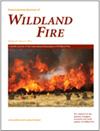Remote sensing applications for prescribed burn research
IF 2.9
3区 农林科学
Q1 FORESTRY
引用次数: 0
Abstract
Prescribed burning is a key management strategy within fire-adapted systems, and improved monitoring approaches are needed to evaluate its effectiveness in achieving social-ecological outcomes. Remote sensing provides opportunities to analyse the impacts of prescribed burning, yet a comprehensive understanding of the applications of remote sensing for prescribed burn research is lacking. We conduct a literature review of 120 peer-reviewed publications to synthesise the research aims, methodologies, limitations and future directions of remote sensing for the analysis of prescribed fire. Studies evaluating management outcomes found prescribed burning effective for wildfire risk reduction, yet few analysed co-benefits or trade-offs with other management goals. Most studies use passive, spaceborne, low spatial resolution sensors, characterised in the literature as consistent and accessible data sources but limited in detecting small, low-severity and short-duration fires characteristic of prescribed burns. In contrast, active remote sensing approaches including LiDAR are less frequently employed, but show promise for highly accurate, spatially explicit 3D vegetation and fuel load mapping. Remote sensing advances toward higher spatial resolution, more frequent revisit, denser spectral sampling and more data across the electromagnetic spectrum are critical to advancing prescribed fire research, addressing current methodological gaps, and improving fuels and fire management capacity.遥感应用于规定烧伤研究
规定焚烧是火适应系统中的一项关键管理策略,需要改进监测方法,以评估其在实现社会生态成果方面的有效性。遥感技术为分析规定焚烧的影响提供了机会,但对遥感技术在规定焚烧研究中的应用还缺乏全面的了解。我们对 120 篇经同行评审的出版物进行了文献综述,总结了遥感技术在分析规定燃烧方面的研究目的、方法、局限性和未来发展方向。对管理成果进行评估的研究发现,规定燃放能有效降低野火风险,但很少有研究分析了规定燃放与其他管理目标之间的共同效益或权衡。大多数研究使用的是被动式、机载、低空间分辨率传感器,这些传感器在文献中被描述为一致且可访问的数据源,但在探测规定燃烧所特有的小型、低严重性和持续时间短的火灾方面却很有限。相比之下,包括激光雷达在内的主动遥感方法使用较少,但在高精度、空间明确的三维植被和燃料负荷绘图方面前景看好。遥感技术向更高的空间分辨率、更频繁的重访、更密集的光谱采样和更多的电磁波谱数据方向发展,对于推进预设火灾研究、解决当前方法上的差距以及提高燃料和火灾管理能力至关重要。
本文章由计算机程序翻译,如有差异,请以英文原文为准。
求助全文
约1分钟内获得全文
求助全文
来源期刊
CiteScore
5.50
自引率
9.70%
发文量
67
审稿时长
12-24 weeks
期刊介绍:
International Journal of Wildland Fire publishes new and significant articles that advance basic and applied research concerning wildland fire. Published papers aim to assist in the understanding of the basic principles of fire as a process, its ecological impact at the stand level and the landscape level, modelling fire and its effects, as well as presenting information on how to effectively and efficiently manage fire. The journal has an international perspective, since wildland fire plays a major social, economic and ecological role around the globe.
The International Journal of Wildland Fire is published on behalf of the International Association of Wildland Fire.

 求助内容:
求助内容: 应助结果提醒方式:
应助结果提醒方式:


